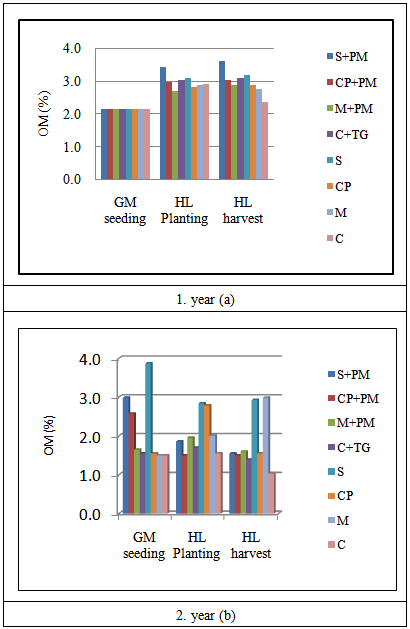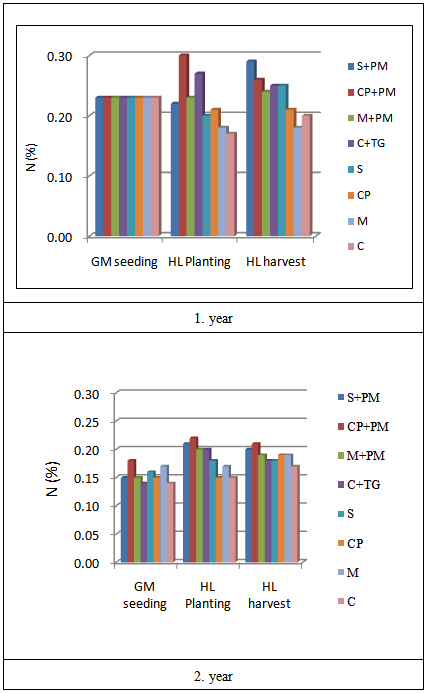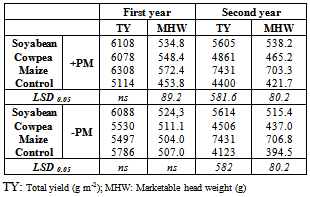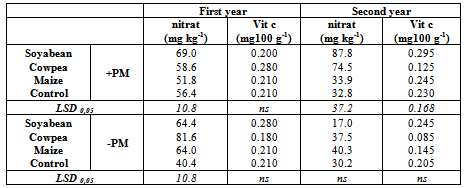| [1] | Tüzel, Y., Karaçancı, A., Gül A, Anaç, D., Okur, B., Ongun, A.R., Yoldaş, Z., Madanlar, N., Gümüş, M., Tüzel, İ.H. ve Engindeniz, S., 2004. “Organic cucumber growing in the greenhouse”. 2004. Acta Horticulturae, 729: 277-280. |
| [2] | Kaplan, M., Sönmez, S. ve Tokmak, S. 1999.“ Well Water Nitrate Contents of the Antalya-Kemer Region”. Turkish Journal of Agriculture and Forestry 23: 309-313. (In Turkish) |
| [3] | Zang, M.K. and Fang, L.P., 2007. “Effect of tillage, fertilizer and green manure cropping on soil quality at an abandoned brick making site”. Soil&Tillage Resercah 93: 87-93. |
| [4] | Campiglia, E., Campiglia, E.,. Caporali, L.P. F,. Radicetti, R., and Mancinelli R, 2010.“Hairy vetch (Vicia villosa Roth.) cover crop residue management for improving weed control and yield in no-tillage tomato (Lycopersicon esculentum Mill.) production”. R.European Journal of Agronomy vol. 33 issue 2 August, 2010. p. 94-102 |
| [5] | Askegaarda, M., Olesen, J.E.,. Rasmussenb, I. A., and Kristensen, K., 2011. “Nitrate leaching from organic arable crop rotations is mostly determined by autumn field management”. Agriculture, Ecosystems and Environment 142: 149-160 |
| [6] | Anaç, D., ve Okur, B., 1996.“ Soil Fertility Through Natural Ways Improve”. Ekolojik Tarım Org. Derneği,Bornova-İZMİR. (In Turkish). |
| [7] | Açıkgöz, E., 2001“Forage crops”. Uludağ Üniversitesi Güçlendirme Vakfı Yayınları: 182, Bursa. (In Turkish) |
| [8] | Beşirli, G., 2003. “Rotation Organic Vegetable Production, Product Ranking With Production Systems”..www.bahce.biz/organik/organik_ sebze.htm.-47k (accessed: 28.04.2005). (In Turkish). |
| [9] | Soyergin, S., 2006. “Protection of soil fertility in organic farming, organic fertilizers and soil improvers”. Sustainable Organic Agriculture Sector Sectoral Strategies and Applications. 222-246. (In Turkish). |
| [10] | Stagnari, F. And Pisante, M. 2010“Managing faba bean residues to enhance the fruit quality of the melon (Cucumis melo L.) crop”. Scientia Horticulturae 126(3) 317-323. |
| [11] | Kavdır, Y., Çetin, S. C., Öztürkmen, A.R., and Öztürk, H.S., 2006. “The importance of soil quality in organic farming. To gain competitive advantage Sustainable Organic Agriculture Sector Sectoral Strategies and Applications”. (In Turkish). |
| [12] | Arriaga, H. Núñez-Zofio, M.,. Larregla, S , and Merino, P., 2011, “Gaseous emissions from soil biodisinfestation by animal manure on a greenhouse pepper crop”. Crop Protection 30: 412-419. |
| [13] | Nolan, T., Troy, S. M., Healy, M. G., Kwapinski, W., Leahy, J. J., and Lawlor, P. G. 2011. “Characterization of compost produced from separated pig manure and a variety of bulking agents at low initial C/N ratios”. Bioresource Technology 102(2011): 7131-7138. |
| [14] | Sullivan, P. “Overview of Cover Crops and Green Manures” 2003. http://attra.ncat.org/attra-pub/covercrop.html.(accessed: 27.01.2013). |
| [15] | Urzua, H., Urzua, J. M., and Pizarro, R. 2001, “Pre-selection of Rhizobium leguminosarum cv. Viceae strains in forage vetch for use as green manure”.Ciencia-e-Investigacion-Agraria 28(1): 3-6. |
| [16] | İnal, İ., Kuşvuran, A., Tansı, V., and Sağlamtimur, T., 2005. Tigem. (accessed::26.04.2005) www.tigem.gov.tr/guncel/ munavebe.asp-110k |
| [17] | Olesen, J. E., Askegaard, M., and. Rasmussen, I. A., 2009. “Vinter creal yield as affecd by animal manure and green manure in organic arable farming”. European Journal of Agronomy 30: 119-128 |
| [18] | Thorup-Kristensen, K., Magid, J., and Jensen, L. S., 2003. “Catch crops and green manures as biological tools in nitrogen management in temperate zones”. Advances in Agronomy 79: 227-302. |
| [19] | Muller, J C., Denys, D, Morle, G., and Mariotti, A., 1989. “Influence of catch crops on mineral nitrogen leaching and its subsequent plant use”. Management Systems to Reduce Impact of Nitrates. |
| [20] | Cavigelli, M. A. and Theien, S .J. 2004. “Phosphorus bioavailability following incorporation of green manure crop”. 2004. Soil Science Society of America Journal 67: 1186-1194. |
| [21] | Lehn-Reiser, M., Munch, J.C. , Chapot, J. Y., Ottow, J. C., 1990. “Field measured denitrification from a calcareous inceptisol after green manuring”.Mitteilungen-der-Deutschen-Bodenkundlichen-Gesellschaft 60: 233-238. |
| [22] | Thonnissen, C., Midmore, D. J., Ladha, J.K., Holmer, R.J., and Schmidhalter, U. 2000. “Tomato crop response to short-duration legume green manures in tropical vegetable systems”. Agronomy Journal 92: 245-253. |
| [23] | Sorensen, J N. and Thorup-Kristensen, K., 2005. “An organic and environmentally friendly growing system for greenhouse tomatoes” http://orgprints.org/4624/ (accessed: 7.4.2005). |
| [24] | Karaçancı, Aand Tüzel,. Y., 2006. Karaçancı A, Tüzel Y (2006) Effects of some organic fertilizers on yield and fruit quality of organic cucumbers grown in greenhouses.In: Third National Organic Agriculture Symposium, 1–4 November 2006, Yalova, pp. 297–307 (in Turkish). |
| [25] | Vural, H., Eşiyok, D., and Duman, İ., 2000 Cultural Vegetables. Ege University Publications. 166. ISBN:975-97190-0-2 (In Turkish). |
| [26] | Pearson, D., 1970. “The Chemical Analysis of Foods (6th ed.)”. Chemical Publishing Co. Inc., New York, USA. |
| [27] | Fresenius, W., Quentin, K. E., and Schneider, W., 1998. “Water Analysis. A Practical Quide to Physicochemical, Chemical and Microbiological Water Examination and Quality Assurance”. Springer-Verlag, |
| [28] | Allen, R. G., Pereira, L. S., Raes, D., Smith, M., 1998. “Crop Evapotranspiration: Guidelines for Computing Crop Water Requirements”. FAO Irrigation and Drainage Paper: 56, Rome. |
| [29] | Bremner, J. M., 1965. “Total nitrogen”. Editor C.A. Black, Methods of Soil Analysis Part 2. America Society of Agronomy Inc. Publisher, Madison, Wisconsin, U.S.A. pp. 1149-1178. |
| [30] | Rauterberg, E. and Kremkus, F. 1951. “Bestimmung von gesamthumus und alkalilöslichen humusstoffen im boden. Z.f Planzenernaehrung,“. Düngung und Bodenkunde. Verlag, Chemie GmbH. Weinheim. |
| [31] | Aybak, H.Ç. 2002. “ Growing Lettuce ”. Hasad Yayıncılık. (In Turkish) |
| [32] | Eroğul, D., 2002. “Comparison of the use of Zeolite and perlite in crisp head lettuce growing“. Ege University, Izmir Turkey. (In Turkish). |
| [33] | Yuri, J. E., Resende, G. M. Mota, J. H., Souza, R.J. , and Carvalho, J. G., 2006. “Iceberg lettuce production in function of doses and application time of zinc”. Ciênia e Agrotecnoloia 30(4): 665-669. |
| [34] | Valšíková, M, and Viteková, A., 2006. “The effect of Lignofert organic fertilizer on formation and quality of head lettuce yield”. Horticultural Science (Prague) 33(3): 114-118. |
| [35] | Polat, E., Demir, H., and Onus, A. N., 2008. “Comparison of some yield and quality criteria in organically and conventionally-grown lettuce”. African Journal of Biotechnology 7 (9): 1235-1239. |
| [36] | Açıkgöz, E., 1995. “Forage Crops”, 2. Basım. Uludağ Üniversitesi Basım Evi, Bursa.(In Turkish) |
| [37] | Sloan, D. R., Kidder, G., and Jacobs, R. D., 2003.“Poultry Manure as a Fertilizer”. PS1 IFAS Extension. University of Florida, p. 241. |
| [38] | Singh, Y., Singh, B., Maskina, M.S. and Meelu, O. P., 1987. “Effect of organic manures, crop residues and green manure (Sesbania aculeata) on nitrogen and phosphorus transformations in a sandy loam at field capacity and under waterlogged conditions”. Biology and Fertility of Soils 6(2): 183-187. |
| [39] | Thorup-Kristensen, K., 1999. “Root growth and soil nitrogen depletion by onion, lettuce, early cabbage and carrot. International Conference on Environmental Problems Associated with Nitrogen Fertilisation of Field Grown Vegetable Crops”. Acta Horticulturae 563: 201-206. |
| [40] | Eskici, Y., 2004. “Organic Waste, Microbiology and Soil”. 2004. http://www.bugday.org/article.php?ID=29(accessed:3.4.2007). (In Turkish) |
| [41] | Thorup-Kristensen, K., 1993. “Effect of nitrogen catch crops on the nitrogen nutrition of a succeding crop, I: Effects through mineralization and pre-emptive competition”. Acta Agricultura Scandinavica, Section B, Soil and Plant Science 43: 74-81. |
| [42] | Thorup-Kristensen, K., 1994. “Effect of nitrogen catch crop species on the nitrogen nutrition of a succeding crops”. Fertilizer Research 37: 231-239. 649. |



 Abstract
Abstract Reference
Reference Full-Text PDF
Full-Text PDF Full-text HTML
Full-text HTML




